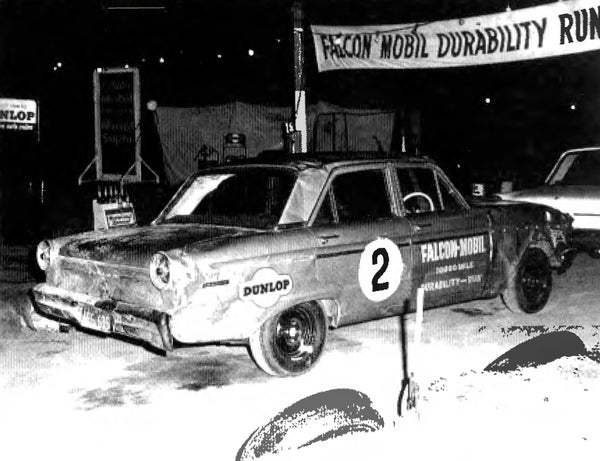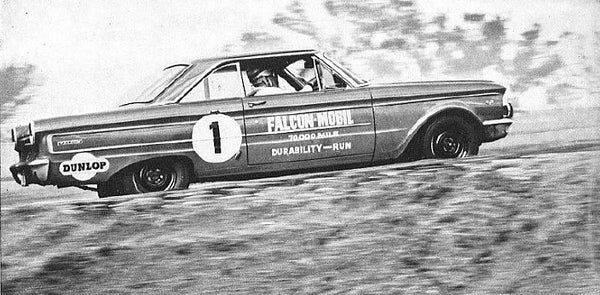By 1964, 3 years after the introduction of the Ford Falcon into Australia, sales had dropped to an alarming number and Ford Australia lost £4.89 million ($9.8 million), the biggest loss in any 12 month period in the history of Ford.
Sales had been strong in the first couple of years with the XK models and its much improved replacement the XL. Unfortunately, the continuing complaints from owners and fleet buyers about weak suspension and ball joints and inadequate clutch and tyres, finally took a major toll on sales. The XK models had not stood up to Australia's rugged conditions as expected. With the release of the XL model came a number of changes including a new gearbox, gear change, clutch, carburettor, starter motor, air cleaner, oil filter and engine dampener. The front suspension was modified, but this was still not enough to suit Australia's harsh conditions.
In October 1963, Falcon race drivers Harry Firth and Bob Jane finished first in the Armstrong 500 endurance race held at Philip Island. Their XL Falcon recorded the fastest lap of the race with a top speed of 102mph. Falcons also came in second, third and fourth in their class.

1963 Armstrong 500 Endurance Race winners Harry Firth and Bob Jane
With the race win and the launch of the new XM model in 1964, Ford was expecting a huge increase in sales. But this was not to be. Fleet buyers had turned their backs on the Falcon in favour of buying Holden's.
Marketed as the ‘Golden Quality Falcon’, the 1964 Falcon XM model had 734 changes, including a newly designed clutch and gearbox. All of the XK and XL model problems had been addressed and rectified. However, fleet buyers could not be convinced of the improvements and sales dropped to an all-time low of 47,110 cars.
Ford was in dire need of a miracle to improve sales. With the upcoming release of the XP Falcon in 1965 Ford USA transferred Bill Bourke, an American who was Sales Manager at Ford Canada, to Australia. Bourke came up with the brilliant idea of running an 8 day reliability trial to prove just how good the new XP Falcon was.
The location chosen for this trial was Fords own proving ground in the You Yang ranges, north east of Geelong in Victoria. Bourke’s plan was to run 5 completely stock Falcons, four Deluxe sedans and one Falcon Hardtop, day and night for 8 days until they had covered 70,000 miles. To cover the distance, the cars had to maintain an average speed of more than 70 mph!

The five Falcons taking part in the trial were taken straight from the showroom floor. They were not modified in any way. The only preparation the cars received was to run them in for 2000 miles. Each Falcon was closely scrutineered before and after the trial by the Confederation of Australian Motorsport (CAMS).

The 5 completely stock Falcons XP models, four Deluxe sedans and one Falcon Hardtop
Considered by many experts to be one of the world’s most ambitious promotional stunts ever used for launching a new car, on Saturday 24th April at 8.28am, Wallace Booth, Managing Director of Ford Australia dropped the flag for the start of the event.
From that moment, every minute of the following eight days and nights, the 5 XP Falcons were subjected to a constant pounding on the twisting 2.4 mile test circuit. With tight ‘S’ bends, short straights, a one in four gradient with a sharp downhill left and right ‘S’ bend corner just over the crest, this was said to be Australia’s most tortuous test circuit. Low fog and greasy surfaces caused by heavy dew added to the challenges of the drivers.
Despite crashes, appalling tyre wear, at one stage a set of tyres every ten laps due to the abrasive track surface and the demanding circuit itself, none of the cars suffered from any form of mechanical failure. Three cars left the track at speeds up to 90 mph, one slamming into a rock said to weigh over two and a half tons. All three cars re-joined the circuit after safety inspections and body repairs. No car was rebuilt.

In the closing stages of the durability trial, all the cars were actually recording faster lap times with one car breaking nine of its own earlier records. All up, 49 new Australian time and distance endurance records were recorded.
Hour after hour, day after day, the cars performed magnificently. Stopping only long enough for fuel and driver changes, the Falcons showed no signs of mechanical failure. The engines, suspension and transmissions were pushed beyond the limits on this tortuous event.
After 8 days and driving the equivalent of nearly 3 times around the world, all five Falcons were still speeding around the circuit when the flag dropped at the finish of this brutal trial at 1.42am on Monday 3rd May, 6 hours ahead of expectations. One of the cars, the Falcon Futura 2 door Hardtop averaged a speed of 71.3 mph!

Falcon Futura 2 door Hardtop averaged a speed of 71.3 mph, 24 hours a day for 8 days
Following this magnificent marketing promotion, the Falcon XP won the prestigious Australian ‘Wheels Car of the Year’ award for 1965. Ford went on to sell 71,000 XP Falcons in 19 months, making it the most popular Falcon in Australia at the time.
The new XP Falcon had created automotive history!
Copyright © 2023 carmanualsdirect.com


